Hello Lykkers! The start of a new school year is the perfect moment to introduce children to new experiences—especially in the world of sports.
If your child is full of energy after a long summer or you're looking for a fun way to help them build friendships and stay active, this guide will help you make the right choice. Let’s explore which activities fit each age and personality.
How to Choose a Sport Based on Age?
From Ages 3 to 6: Movement First
At this young stage, the goal isn’t competitive play, but discovering movement. Activities should be playful, creative, and gentle. Dance, gymnastics, swimming, and scootering are great options. These help improve balance, coordination, and spatial awareness.
Tips from Experts
Activities with complex objects like rackets or balls might still be too challenging. Instead, choose something simple where your child can explore movement and self-awareness. Disciplines like judo are also adapting for younger children, offering a safe space to learn how to move, fall, and understand the concept of interaction with others.
Session Structure
Keep the activities short and stress-free. Little ones need time to rest just as much as they need to move. Don’t expect quick progress in teamwork—they are just beginning their social journey.
Ages 7 to 10: Time to Explore Variety
More Structure, More Skills
This is the time to introduce sports with rules and more structured learning. Children at this age are usually ready to handle strategy, spatial concepts, and teamwork. Mixing individual and group sports can help them discover their interests and talents.
Sport Options to Consider
Try fencing, swimming, judo, or athletics for individual development. For teamwork, explore basketball, football, or handball. These help improve reaction time, coordination, and understanding of cooperation.
Why Athletics Is a Solid Choice
Athletics combines a variety of activities like running, jumping, and throwing. It builds strength, speed, and endurance in a fun and diverse environment. The early years are focused on overall development rather than intense specialization.
From Age 10 and Up: Passion and Progress
Greater Maturity, Greater Focus
At this stage, children are better at refining techniques, showing dedication, and committing to regular practice. Sports can help them manage changes in both their bodies and minds during this stage of growth.
Discovering Long-Term Interests
This is an excellent time for your child to find a sport they genuinely enjoy and start developing advanced skills. Group activities also strengthen social connections, while solo sports can foster concentration and discipline.
Choosing a Sport Based on Personality
Independent Spirits
If your child prefers personal space and self-direction, activities like athletics, swimming, or climbing can be ideal. They encourage focus, agility, and personal growth without pressure from a team setting.
For Better Concentration
Certain disciplines can help sharpen attention and mental clarity. Any consistent physical activity can refresh the mind and ease daily tension. Activities like football, basketball, swimming, or racquet sports support both mental and physical balance.
High-Energy Kids
For those who are always in motion, energetic group sports help direct their enthusiasm into structure. Football, basketball, and activities that promote coordination and movement are excellent. For individual focus, consider combat-based disciplines such as boxing, karate, or judo, which offer structure and physical challenge.
Not All Kids Love Running Around
Some children may not enjoy traditional movement-based activities. That’s okay. Alternatives such as archery, darts, or precision-based games can build focus, patience, and fine motor skills, offering similar benefits in a different form.
Final Thoughts
Let Passion Lead
The key to long-term success is letting children explore freely. While practical details like schedules, budget, and location matter, genuine interest should come first. A child is more likely to stay engaged when the activity feels enjoyable, not forced.
Be Open to Unconventional Options
Not every child will enjoy the typical sports offerings. Activities in nature—like hiking, kayaking, or mountain biking—can be thrilling alternatives. These can spark a lifelong appreciation for staying active in unique ways.
Keep it Fun
The real goal is helping your child grow through movement. Encourage exploration, allow for change, and most of all, keep the fun alive. Sports should feel like an exciting part of life—not a chore.


